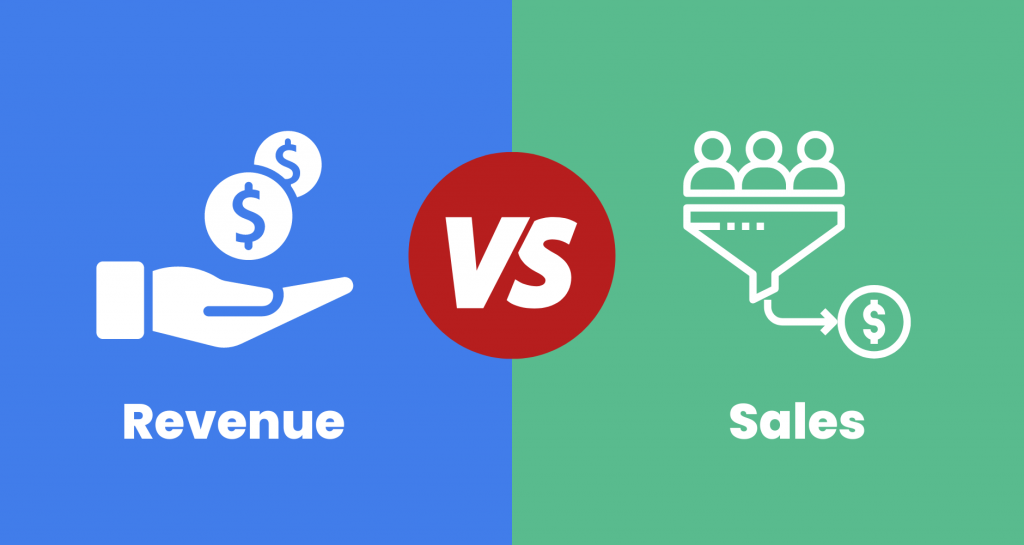Revenue and sales are two closely related financial concepts that are often used interchangeably but in fact, they have distinct differences. Both terms represent income generated by a business through its operations, and they play a critical role in evaluating a company’s financial performance and growth potential. However, they shouldn’t be confused.
This article will review the similarities and differences between sales and revenue as well as their implications for financial statements and business growth.

Revenue vs sales: similarities and differences
Sales, also known as gross sales, refer specifically to the total income generated from the sale of products or services before accounting for any deductions such as discounts, returns, or allowances. Revenue, on the other hand, represents the overall income a company generates from its various activities, including sales, and is sometimes referred to as net sales when adjusted for deductions.
Here is a breakdown of the differences and similarities between revenue and sales.
Revenue vs sales: differences
Scope
Sales generally refer to the income generated from the sale of goods or services by a company. It represents the primary source of income for most businesses. Revenue, on the other hand, is a broader term that encompasses all sources of income for a company, including sales, but also other sources such as interest, dividends, rental income, or royalties.
Components
Sales are typically a single component of a company’s revenue. Revenue includes all the money a company receives from various sources, including sales, but also non-operating sources like investments, asset sales, or any other incidental income.
Revenue vs sales: similarities
Income generation
Both revenue and sales represent different aspects of the income generation process for a company. Sales are the primary source of income for most businesses, while revenue represents the total income generated from all sources. In this context, they both relate to a company’s financial performance and success.
Financial reporting
Both revenue and sales are essential financial metrics that appear on a company’s financial statements, specifically the income statement. Revenue is typically reported as the top line, or gross income, while sales are often a component of the revenue calculation.
Performance evaluation
Revenue and sales are both used to evaluate a company’s financial performance and growth potential. By analyzing trends in revenue and sales, businesses can identify areas of strength or weakness, adjust their strategies, and allocate resources effectively.
Impact on profitability
Both revenue and sales have a direct impact on a company’s profitability. Higher sales contribute to increased revenue, which can lead to higher profits, assuming the company can control its costs and expenses. However, it’s essential to note that increasing sales or revenue doesn’t always guarantee higher profitability, as other factors such as cost management, pricing strategy, and market conditions also play a role.
What are net sales?
Net sales refer to the total revenue a company generates from its business activities, such as selling goods or services, after accounting for returns, allowances, and discounts. It is a key performance indicator that businesses use to measure their financial health and success.
To calculate net sales, you can use the following formula:
Net Sales = Gross Sales – (Sales Returns + Allowances + Discounts)
- Gross Sales: The total amount of revenue generated from selling goods or services before accounting for any deductions.
- Sales Returns: The value of goods or services that customers have returned to the company, usually due to defects or dissatisfaction.
- Allowances: Reductions in the selling price given to customers for various reasons, such as damaged goods, bulk purchases, or promotional offers.
- Discounts: Price reductions provided to customers as an incentive to purchase, which can include volume discounts, early payment discounts, or seasonal discounts.
By deducting returns, allowances, and discounts from gross sales, net sales provide a more accurate representation of the company’s actual revenue and its ability to generate profit. This metric is useful for assessing a company’s performance, comparing it with competitors, and evaluating the effectiveness of its sales and marketing strategies.
Learn about e-commerce sales revenue and basics of online sales.
Revenue and sales on financial statement
Revenue and sales are important financial metrics that appear on a company’s financial statements, specifically on the income statement. The income statement, also known as the profit and loss statement or statement of operations, provides a summary of a company’s revenues, expenses, and profits over a specific period, usually a quarter or a year.
Revenue on the Income Statement
Revenue, often referred to as the “top line” or gross income, is reported at the top of the income statement. It represents the total amount of money a company earns from its business activities, including the sale of goods or services, rental income, royalties, and investment income. The revenue reported on the income statement is typically the net revenue, which is the gross revenue minus any sales returns, allowances, or discounts.
Sales on the Income Statement
Sales, a component of revenue, represent the income generated from the sale of goods or services by the company. In most cases, sales are the primary source of revenue for a business. Sales are often broken down into different categories or segments, such as product lines or geographical regions, to provide a more detailed understanding of a company’s performance.
How to increase your sales and revenue
Increasing sales and revenue is crucial for businesses to grow, improve profitability, and stay competitive in the market. Here are some strategies to boost sales and revenue:
Understand your target market
Research and understand your target market’s needs, preferences, and pain points. Create customer personas and tailor your products, services, and marketing messages to address the specific needs of your target audience.
Develop and diversify your product or service offerings
Expand your product or service portfolio to cater to a wider customer base or to address unmet needs within your target market. This can help you reach new customers and increase sales from existing customers.
Enhance customer experience
Focus on providing exceptional customer service and a seamless buying experience. Happy customers are more likely to purchase again and refer others to your business, leading to increased sales and revenue.
Optimize pricing strategy
Review your pricing strategy and make adjustments if necessary. Experiment with different pricing models, such as volume discounts, promotional offers, or tiered pricing, to find the right balance between attracting customers and maximizing profitability.
Improve sales and marketing efforts
Invest in sales training and enablement to improve your sales team’s effectiveness. Strengthen your marketing efforts through a mix of online and offline channels, targeted advertising, content marketing, and social media to reach more potential customers.
Leverage digital channels
Expand your online presence through an e-commerce platform, social media, and other digital channels. By offering your products or services online, you can tap into a broader customer base and generate additional sales.
Foster customer loyalty
Implement customer loyalty programs or reward systems to encourage repeat business and referrals. Loyal customers are more likely to make more purchases and recommend your products or services to others.
Establish partnerships
Collaborate with complementary businesses or form strategic alliances to reach new markets, share resources, and increase your overall sales and revenue potential.
Monitor and analyze performance data
Regularly track and analyze sales and revenue data using sales tracking software to identify trends, areas of strength or weakness, and opportunities for improvement. This information can be helpful to make informed decisions about product offerings, pricing, marketing efforts, and resource allocation.
Innovate and adapt
Stay informed about industry trends, customer preferences, and emerging technologies. Continuously innovate and adapt your products, services, and business processes to stay ahead of the competition and meet changing market demands.
By implementing these strategies, businesses can increase their sales and revenue, leading to greater profitability, growth, and long-term success.
Revenue vs sales: closing thoughts
While revenue and sales are related financial metrics, they serve different purposes in evaluating a company’s financial health. Sales provide a snapshot of a company’s ability to sell its products or services, whereas revenue offers a more comprehensive view of the income generated from various activities, accounting for deductions and adjustments.
Understanding the difference between these two concepts is essential for businesses to accurately assess their performance, make informed decisions, and ensure sustainable growth. By carefully tracking and analyzing both sales and revenue through business intelligence tools, companies can develop effective strategies to optimize their operations and maximize profitability.

.png)




